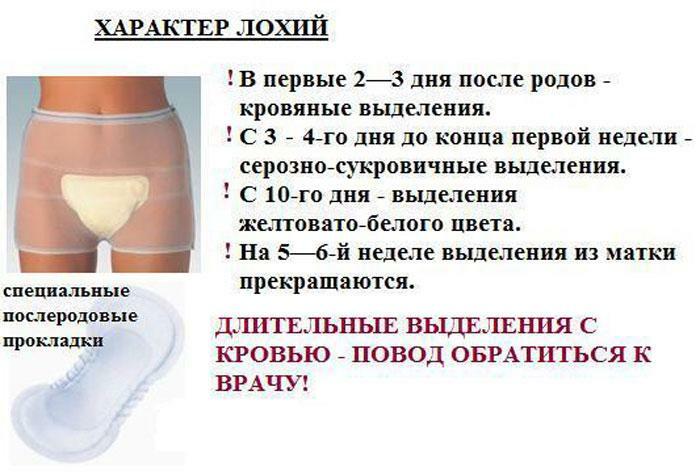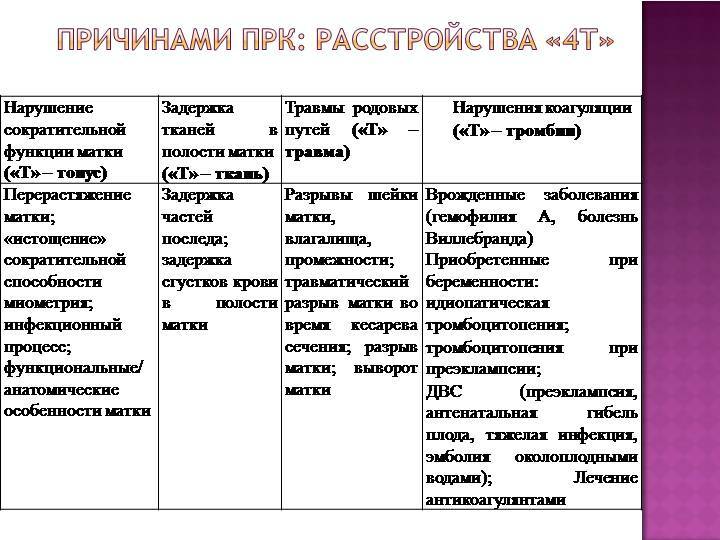Bleeding in the early postpartum period is a normal physiological process that should not frighten a woman. After the expulsion of the fetus and placenta, the uterus is actively contracting, "pushing out" the remaining blood, clots and everything that remains in its cavity after childbirth. A few days after delivery, the bleeding becomes smaller and is replaced by bloody discharge - lochia. They will bother the woman about 5-8 weeks, until the endometrium in the uterus completely heals.
Lochia do not pose a threat to the female body, but it is necessary to constantly monitor their number and consistency so as not to miss the beginning of true uterine bleeding.

How long does bleeding occur after delivery
Content of material
- 1 How to distinguish lochia from bleeding?
- 2 How long does it bleed after giving birth?
- 3 Bleeding increased one month after delivery
- 4 When should I see a doctor?
- 5 Can bleeding stop after a few days?
- 5.1 Video - Postpartum period. Recovery. Uzi. Food. Hygiene
- 6 Can bleeding be menstruation?
How to distinguish lochia from bleeding?
Bleeding that occurs in the postpartum period is one of the most common causes of death of women. In order not to miss the time and seek medical help on time, it is important to know the signs by which pathological bleeding can be distinguished from normal discharge.
| Symptom | Bloody postpartum discharge( lochia) | Bleeding |
|---|---|---|
| For what time is the hygiene pad completely filled? | 2-4 hours | 40-60 minutes |
| Emissions color | Dark red, brown | Bright scarlet |
| Characteristic of the | discharge Normal, smearing | Abundant, the blood comes out with jerks |
| Painful sensations | None | Pain may appear in the lower abdomen,lateral parts of the waist, the region of the coccyx and sacrum. The nature of pain - pulling, can be replaced by thrusting sensations |
| Changes in well-being | Usually does not occur | Dizziness appears, possible loss of consciousness |
| Nausea and vomiting | It is easy nausea, but it is noted in rare cases( usually with inaccuracies in the diet) | Nausea strongly pronounced, there may be vomiting. Vomit with normal odor, without bile acids |

Character of lousy
Important! The emergence of any of the signs( the main of which is the need to change hygiene products every hour), indicating the possibility of bleeding, it is necessary to call an "ambulance".Before her arrival, the woman must be laid on the bed, raising her legs slightly. This situation will help to avoid great blood loss.
Lochia usually appears in a woman on day 2-3 after childbirth. Up to this point, bleeding is considered normal, but it is also necessary to monitor the amount of blood produced. If you still have to change the hygiene pads every 45-60 minutes while in the maternity hospital, you should inform the on-duty midwife or nurse about it.
How long does bleeding occur after delivery?
Bloody discharge after the birth of a child can normally last up to 8 weeks. In young women, the process of recovery is faster, so they usually reduce this period to 5-6 weeks. A big role in this is the nutrition of women in the postpartum period. In order for the endometrium to heal faster, it is necessary to include the following products in your diet:
- vegetable oils of cold pressing( premium class);
- nuts( Brazilian, Greek, hazelnuts);
- dried fruits( dried apricots, figs);
- greens( any kinds of greens and leaf salads);
- fatty fish;
- meat( veal, beef, lean pork and lamb);
- fruits and vegetables.

Causes of postpartum bleeding
After the placenta is expelled, an open wound is formed at the site of its attachment to the uterine wall, which bleeds until complete healing. To ensure that the damaged endometrium is quickly tightened, the woman should be calm, do not lift heavy things and objects that exceed the weight of the baby, include in the menu more foods containing vitamins E, A and ascorbic acid. Of drinks is especially useful decoction of rose hips and crimson leaves. Extracts contained in raspberry leaves stimulate uterine contractions and help to cope more quickly with postpartum hemorrhage.
Bleeding increased one month after the birth of
Any change in the number of discharges a few weeks after delivery is an alarming sign that may indicate the development of serious diseases. If the amount of secreted blood has increased dramatically, you need to contact a gynecologist. The doctor will examine, probe the uterus, determine if it is painful, and make a conclusion about the need for in-patient examination.
Some mothers refuse the proposed hospitalization, because they do not want to part with the baby. Doing this in no case is not worth it, especially if a woman in the future plans the birth of another child. The most common pathology that occurs in newly-given women is inflammation of the uterine mucosa( endometritis).This is a serious disease that can lead to infection of the body and the onset of a purulent-inflammatory process. If bacterial organisms and toxins enter the systemic circulation, the likelihood of sepsis( contamination of the blood) will be very high. In the absence of timely assistance and improper treatment, a lethal outcome is possible.

Risk factors for postpartum hemorrhage
Please note! Annually about 11 thousand women all over the world die from the abundant blood loss after childbirth. According to the conclusions of experts, more than half of them could be saved if they were on time to go to the hospital.
When should I see a doctor?
The postpartum period is a dangerous time when the likelihood of complications increases several times. The woman's body is weakened by pregnancy and labor, and therefore can not cope with the stresses that become significantly greater after the appearance of the baby in the house. If possible, during this period it is better to take the help of a grandmother, sister or girlfriend who could take some of the responsibility for taking care of the baby to take over. If a woman has to cope with everything on her own, you must carefully treat your own organism. To address to the observing gynecologist it is necessary in the following cases:
- of allocation have got brightly scarlet color;
- discharge increased after 2-4 weeks after delivery;
- appeared soreness in the abdomen or lower back;
- release has acquired an unpleasant odor;
- from the uterus began to excrete clots;
- regularly began to rise temperature.

Diagnostic bleeding criteria
advice! In women breastfeeding, the measurement of temperature in the armpit is poorly informative, especially in the first days after the birth of the child. If the lactation has not yet been established, there may be a rise in temperature due to small lactostasis, so the puerperas are advised to measure body temperature on the elbow.
Can bleeding stop after a few days?
In some cases, a woman may notice that after 4-7 days after delivery, the discharge stopped completely. This happens abruptly and is often accompanied by a deterioration in well-being. If this situation has arisen, you need to urgently go to the hospital, since the only reason for this phenomenon is the hematometer( blood accumulation in the uterus).
Blood can accumulate because of insufficient uterine contraction, so it is recommended that a woman take all measures to prevent such a condition. The nurse will describe this in detail after the woman is transferred to the postnatal ward. To the uterus to cut well, and also to remove the edema of young mothers, it is necessary:
- to lie more often and sleep on the stomach;
- often get out of bed and walk around the ward or along the corridor;
- put the cold on the bottom of the stomach( warmers or ice bottles can be taken in the refrigerator compartment).

Methods of determining the volume of blood loss
If you can not avoid the formation of hematomas all the same, it is important to contact the hospital in time, as the stagnation of blood in the uterus can lead to the spread of infection and inflammation in the cavity of the organ. The main symptoms of the pathology are the cessation of discharge and strong pulling pain in the lower abdomen. When these symptoms appear, a woman needs to call an "ambulance".
A doctor in the department will conduct ultrasound diagnosis, determine an exact diagnosis and, if confirmed, prescribe treatment. Stimulate contraction of the uterus can be with the hormone oxytocin, but most experts prefer a more effective method - surgical scraping or vacuum aspiration. Both procedures are rather traumatic, but their application is necessary to prevent dangerous complications.
Video - Postpartum period. Recovery. Uzi. Food. Hygiene
Can bleeding be menstruation?
If the discharge stopped within 1-1.5 months after delivery, and after a couple of weeks started again, it could be an early menstruation. If a woman is not disturbed by nausea and dizziness, the temperature is normal, and discharge is moderate, you should not worry. It is necessary to observe the situation for 3-5 days. Menstrual blood has a darker shade and a peculiar smell, so distinguishing the monthly from bleeding is simple enough.
Important! Some women believe that lactation is a 100% effective method of preventing unwanted pregnancies, and it is believed that there can be no menstruation during breastfeeding. In 85% of cases this is true, but sometimes a woman begins to have menstruation after 2 months after the birth of the child. In the same period, the ability to conceive is restored, so you need to take care of contraception, if in the near future children are not included in the plans of the newly mum.
True uterine bleeding after birth is a rare complication, so do not panic if suddenly the discharge has intensified. This can be the result of increased physical activity or lifting weights, so you need to calm down and adjust the mode of work and rest. But if too much blood is allocated, and the woman's condition worsens, medical help is needed in the shortest possible time.



